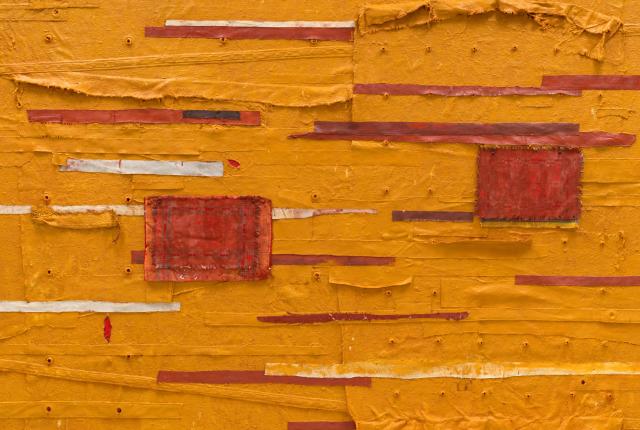THE MERE THOUGHT that ordinary materials—rags, metal grommets, bandages, straw, linoleum, and other utilitarian objects—could be used to make art elevates their mundanity. Galisteo-based artist Harmony Hammond goes further in using these materials to counter the very idea of what art is, infusing her abstractions with social and political meaning.
“All materials have histories, have memories,” says Hammond, a longtime New Mexico resident and a prominent voice of the 1970s feminist art movement. “I like to think of my work as participating in the narrative of modern abstraction at the same time it interrupts and subverts that narrative.”
The artist, writer, and curator’s latest solo exhibition, FRINGE, opened at SITE Santa Fe in February and runs through May 19. (Admission is always free.) In the show, the mixed-media abstractions are in dialogue with her work from the 1970s, effectively blurring the line between two- and three-dimensional modes of artistic representation.
Hammond’s topographies use materials that can be associated with binding and restraint, damage to the body, and healing. In Bandaged Grid #1, a mixed-media canvas from 2015, bandages streak the surface like striations in rock. Red, like blood, oozes from grommets peppering the surface.
“Straps restrain, suggest binding, bandaging, bondage, but also embrace the painting body,” she says. “The fabrics are torn, frayed, pieced, and patched. There are loose ends. The seams are left showing. Cords and ropes suggest possibilities of connection. Paint is used to suture, is used as a poultice.”
Hammond’s materials and techniques are both aesthetic and symbolic. “Her work actively challenges and disrupts dominant historical narratives that have consistently excluded women and LGBTQIA+ individuals,” says SITE Santa Fe curator Brandee Caoba.
Born in Hometown, Illinois, Hammond lived in New York City in the early 1970s and became a founding member of A.I.R. (Artists in Residence) Gallery, the first all-women artists cooperative gallery in the U.S. In 1976, she co-founded Heresies Collective with art critic and historian Lucy Lippard and artists Miriam Schapiro, Joan Snyder, and May Stevens. The collective encouraged and supported feminist ideologies through the long-running publication Heresies: A Feminist Publication on Art and Politics.
In the 1980s, Hammond became one of several Heresies alumni, including Lippard, Stevens, and artist Sabra Moore, to settle in New Mexico. As a lesbian artist, she struggled against the anti-LGBTQIA+ sentiments at a time when doing so meant possible career suicide. Her dedication as a curator and teacher to younger generations has cemented her legacy as a seminal feminist art figure.
Throughout her career, Hammond has often used fabrics and techniques that reflect the intersection of so-called domestic arts (stitching, sewing, and weaving, for example) with the fraught realities of political and sexual violence against women.
“Woven into the labor of layered paint, textured surfaces, and frayed seams is the weight of untold stories and marginalized histories,” Caoba says. She notes that the works in FRINGE “bear the marks of struggle, mending, and repair.”
The exhibition’s title references the history of textiles and fabrics, but also emphasizes Hammond’s ongoing interest in edges, margins, and borders, which, she says, are themselves “charged spaces of agency, intersection, and exchange.”
HARMONY HAMMOND: FRINGE
Through May 19.
SITE Santa Fe, 1606 Paseo de Peralta, Santa Fe; 505-989-1199.



